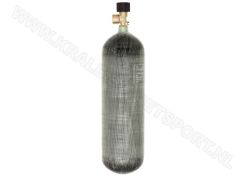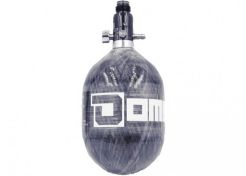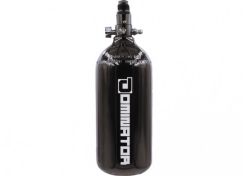What is HPA?
HPA stands for High Pressure Air, compressed air. HPA airsoft replicas use this air as their power source, making them the most consistent replicas around. Where electric AEG replicas can vary a bit in shot-to-shot fps and Gas-powered replicas will see their fps reduced after rapidly cooling down when shooting continuously, HPA will deliver the same fps every shot. This makes for optimal accuracy. We often get asked what the advantage is of an HPA tank vs CO2. Just like the Gas replicas, CO2 will take away heat when shooting rapidly and continuous. The lower the temperature of the CO2 cartridge, the less power it will deliver until it’s warmed up again by resting. The result is a shifting point of impact. If you use an HPA replica, there’s no cooling down. Just the same power for every shot.
What is an airsoft HPA tank used for?
An airsoft HPA tank is required as an attachment to your HPA replica in order to take a significant amount of compressed air with you. There’s no space inside the replica to do that, without altering the realistic look of the replica. So to keep the replica realistic, while still having enough air to keep playing for a substantial time, the replica is attached with a non-intrusive subtle hose to an external airsoft HPA tank that you’ll carry with you in a HPA tank bag or HPA tank pouch.
Which airsoft HPA tank do you need?
The bigger the HPA air tank, the longer you can shoot your replica without the need for refilling. However, the larger the tank, the heavier and bulkier it will be. Luckily, we’ve got multiple HPA tank sizes available to choose from. Easy to take with you are the small HPA tanks, with a capacity between 0.2 and 1 litre. These small HPA air tanks are easy to carry in a HPA tank pouch or even in a pocket. They’re small enough to carry a couple with you for a quick change.
Do you need a bigger volume of compressed air without the need for changing tanks? No worries, we’ve got 4500 psi HPA tanks with a capacity around 5 or even 7 litres. These are quite a lot bigger and require an HPA tank bag or even a backpack to take them with you. They’re great for continuous shooting, although the size means these tanks are often used at home to fill the smaller airsoft HPA tanks.
The even bigger airsoft HPA tanks that we’ve got, aren’t really suitable for carrying while airsofting. They’re industrial tanks and scuba tanks that are also used in sport shooting with PCP air rifles. These tanks are commonly used in airsoft as a home supply to refill your small HPA tanks. That way you’re not queueing at the filling station at the airsoft range, nor are you dependent on the opening times of commercial filling stations like ours. You just have your large airsoft HPA tank filled at a time that suits you best, after which you’ve got your own supply to refill your small HPS tanks at your convenience.
We’ve got carbon fibre HPA tanks and steel ones. The steel tank is a bit more robust and has a longer inspection interval. However, the carbon fibre HPA tank is by far the lightest HPA tank and although a bit less robust than a steel one, they’re still exceptionally strong. With carbon fibre weighing just a fraction of steel, these HPA tanks are pretty popular in airsoft as you’re running around with them a lot.
How do you fill an airsoft HPA tank?
In our store, we’ve got a professional refill station. For a decent price, we’ll fill your airsoft HPA tank with filtered and moist-free air. Getting rid of the moisture, will reduce the chance of corrosion inside the HPA tank, while filtering out dust particles, prevents seals from leaking. We can fill all sizes of HPA tanks, so just bring what you’ve got and we’ll fill it up for you. We do, however, only fill tanks that have passed inspection. More about that in a minute.
It’s also possible to use large tanks to refill your small HPA tanks, by connecting them together and carefully opening the valve, while keeping an eye on the pressure gauge to see the pressure building inside the small tank. After closing the valve, you’ll notice the pressure slightly dropping a bit, as the greater pressure inside the big tank is closed off. Opening the valve in tiny amounts, will let you get right up to the maximum filling pressure inside the small tank.
Another possibility, and one we can absolutely recommend, is putting a regulator in between. With one of those, you just set the pressure one time and that’s it. Just open the valve of the big tank completely and wait until the airflow stops when the right pressure is reached. Close the valves, disconnect the tanks and you’re done, ready for action.
Does an airsoft HPA tank need to be inspected?
Yes, all airsoft HPA tanks need to be periodically inspected. Please note we’re going to describe the legislation for the Netherlands below. Your country might have other legislation, so please inform yourself which rules apply for you.
Our industrial steel tanks need to pass inspection every ten years. Mobile steel scuba tanks are inspected every five years, while carbon ones have a four year interval. The latter also have a lifespan of fifteen years. This is because carbon (carbon fibres bound with synthetic resin) is susceptible to ageing.
The tanks are checked for internal and external damage. Steel tanks can corrode, which is often countered by sand blasting and a zinc coating. Carbon tanks, however, have an aluminium cylinder with a carbon outer. When the carbon fibres are damaged, this will result in an unrepairable weak spot. For this reason, carbon airsoft tanks are often protected with an HPA tank cover.
However, small airsoft HPA tanks are relatively cheap, costing about the same as an inspection would. For this reason, most airsofters just buy a new HPA tank. Understandable, but having it checked would be the durable option.
What parts do I need for an HPA tank?
To connect the airsoft HPA tank to your replica, you’ll need a regulator screwed onto the tank. This ensures the replica gets exactly the right amount of air to meet the speed/power regulations. The regulator sports a (Foster) quick coupler, into which you can click the probe at one end of the filling hose. The HPA replica also has one of those probes, onto which the quick coupler at the other end of the hose can be attached. The advantage of a system with multiple quick couplers is that both replica and airsoft HPA tank can be switched in seconds.
Some regulators feature burst discs. These discs are a sort of safety valves that’ll burst when a certain pressure is exceeded. This’ll prevent damage to your HPA replica, but also prevents damage to the airsoft HPA tank. Often, the tank side of the regulator has a 7.5 k (7500 psi) disc, while the replica side has a 1.8 k disc. They can be renewed or exchanged with burst discs with other limits, which might be convenient when you go airsofting in a country with different power regulations.
Many of you will fill their airsoft HPA tanks at the airsoft field or at a commercial filling point. But some of you will fill the small HPA tanks themselves by means of bigger HPA tanks that are used for air storage. You can also use a compressor. Both large tanks and compressors are available in our store.
Buying an airsoft HPA tank
When you’re looking to buy an HPA tank, there are some things to consider. Capacity is one of the most important ones. If you’re stationary positioned, size really doesn’t matter and you can go as big as you want. But as most of you will be running around a lot, small HPA tanks are more tactile. They’re compact and light, while also easy to stow away. To make sure you’ve got plenty of compressed air with you, it’s best to opt for multiple small HPA tanks that you can store in HPA tank pouches.
Capacity is one thing to consider and next is weight, thus material. Steel HPA tanks are very robust, while carbon HPA tanks are a bit more sensitive to hard knocks. The latter are, however, extremely lightweight. Just a fraction of steel tanks with the same capacity. As an airsofter, you’re carrying around quite some gear, so a carbon HPA tank proves to be pretty popular in airsoft.
Besides the HPA tank, you’ll need other HPA tank parts, such as a regulator and a hose. Maybe some couplers, an HPA tank cover, et cetera. If you already know what you’ll be needing, you can place your order in our online shop. Do you need some advice first? No worries. Please contact our customer service and one of our experts will help you out.






















 Fast & secure delivery
Fast & secure delivery Secure shopping & payment
Secure shopping & payment Lots of expertise
Lots of expertise


